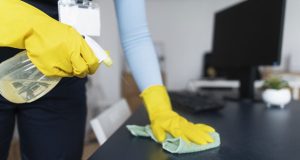British offices and their workers are busier than ever. According to research from Initial Washroom Hygiene, almost half (43%) of office workers say the total number of staff in their office has increased; leading to a shortage of workspace (60%), fewer available car parking spaces (52%), and busier washroom facilities (34%).[1] Additionally, half of British workers say they’re too busy with work commitments to use their holiday entitlement; which is no doubt partly to blame for the third of UK workers who say they’re experiencing anxiety, depression or stress.
As offices become more crowded, it appears that some workers are seeking solace in the washroom. A third of people admit to using their office washroom as place to escape work because they don’t have enough breakout space elsewhere. Another third said they sometimes visit the washroom to get away from their desk but didn’t use the toilet while they were there, and almost two in five (39%) said the office washroom is a good place to seek peace and quiet.
Creating a stress-free environment
If more people are using washrooms and staying in them for longer periods, employers and facilities managers need to ensure their cleaning regime is increased appropriately to reflect this. Officer managers will need to give some thought to how to create a pleasant and stress-free environment which doesn’t further exacerbate the strain employees are under.
Here are five tips for facilities managers looking to create the perfect “rest” room:
1. Increase regular cleaning
With workplace bathrooms becoming busier, it’s more important than ever to focus on regular hygiene procedures. A higher concentration of people moving in and out of washroom areas can increase the levels of bacteria and therefore the risk of germs being passed from person to person, so increasing the regularity of cleaning procedures is a must. Clearly documented cleaning schedules are also vital.
2. Educate and equip employees for good hand hygiene
Washing hands thoroughly after using the toilet significantly helps prevent the spread of germs, bacteria and illness amongst patrons. Equipping washrooms with enough sinks, soap dispensers and hand drying options will help to encourage each visitor to wash and dry their hands before returning to their workstation. Bacteria and germs can spread easily within an enclosed space such as a washroom, so installing no-touch automatic dispensers can also help to reduce the spread of germs by limiting the amount of touch points.
3. Consider air purifiers
In a survey by Initial Washroom Hygiene, 73% of those surveyed said that an unpleasant smell in the washroom would negatively affect their perception of a venue, so scenting is another area that is worth considering. You may want to consider installing air fresheners that automatically dispense fragrance to help neutralise odours and create a pleasant-smelling environment. Scenting products and services are available that can help to control and minimise odours that come from malodour-producing bacteria. An air purifier can also help to eradicate any airborne bacteria and viruses including the flu virus, E. coli, salmonella, streptococcus and rhinovirus.
4. Ensure adequate waste disposal
Initial Washroom Hygiene found that 54% of women in the UK have experienced a situation where the washroom did not have a personal female hygiene unit. Even if your washroom lacks space, you should provide female users with sanitary bins in each cubicle. Doing so means you are offering a safe, discreet and hygienic washroom experience. Not doing so could increase the risk of germs being spread and can result in women flushing their products down the toilet, potentially leading to costly blockages in plumbing.
5. Provide a desk-based line of defence
With one in four office workers saying they don’t wash their hands after going to the bathroom, having hand hygiene processes in place in other areas outside of the washroom is a good idea. Office desk phones, keyboards and mice are all shown to harbour infectious levels of microbes. This figure rises dramatically for shared equipment on ‘hot desks’; which are becoming increasingly popular as companies try to reduce overheads. Simple steps like loading up desk spaces with antibacterial wipes and hand sanitising gels can all generate a marked improvement in hygiene practices amongst employees.
 With office space effectively shrinking as offices become busier, and the pace of work stress levels continuing to rise, we’re likely to see even more people seeking solace in their workplace washroom. Of course, this is an issue for organisations to tackle with their HR and employee experience teams. But in the meantime, facilities managers need to ensure that they are re-thinking their hygiene processes and practices to cope with demand. If you can’t prevent employees from needing some peace and quiet, then you can at least ensure they have clean and hygienic “rest” room in which to catch it.
With office space effectively shrinking as offices become busier, and the pace of work stress levels continuing to rise, we’re likely to see even more people seeking solace in their workplace washroom. Of course, this is an issue for organisations to tackle with their HR and employee experience teams. But in the meantime, facilities managers need to ensure that they are re-thinking their hygiene processes and practices to cope with demand. If you can’t prevent employees from needing some peace and quiet, then you can at least ensure they have clean and hygienic “rest” room in which to catch it.
Written by Jamie Woodhall, UK Technical & Innovation Manager, Initial Washroom Hygiene
[1] Initial Washroom Hygiene, ‘Loo Love’ research, 2018




